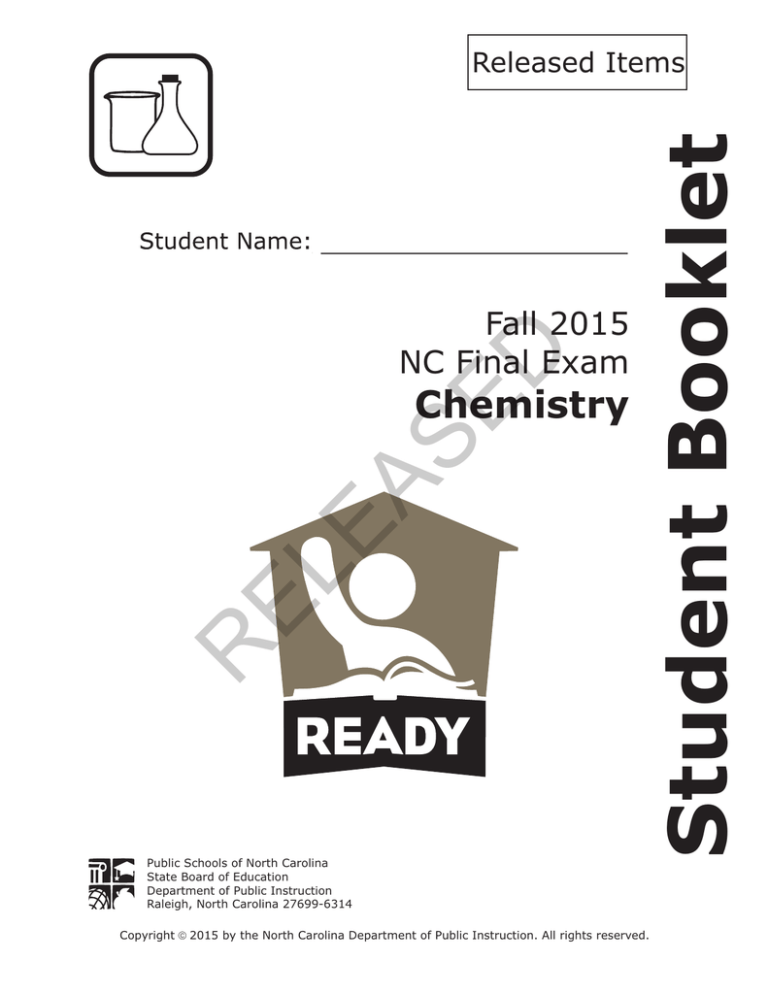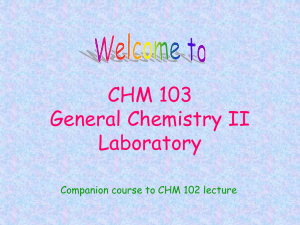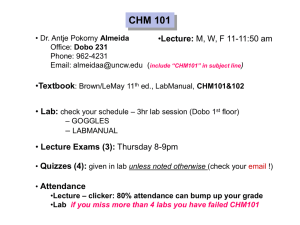
D
Fall 2015
NC Final Exam
R
EL
EA
SE
Chemistry
Public Schools of North Carolina
State Board of Education
Department of Public Instruction
Raleigh, North Carolina 27699-6314
Copyright ã 2015 by the North Carolina Department of Public Instruction. All rights reserved.
Student Booklet
Released Items
CHEMISTRY — RELEASED ITEMS
MgBr
B
MgBr2
C
MgBrO3
D
Mg(BrO3)2
D
How are compounds with metallic bonds similar to ionic compounds?
Both tend to have double and triple bonds.
B
Both tend to have low boiling points.
C
Both tend to have poor conductivity.
D
Both tend to have high melting points.
SE
A
EA
3
A
Which of these elements has the greatest atomic radius?
A
H
B
N
C
Cl
D
Cs
EL
2
What is the chemical formula for magnesium bromate?
R
1
1
Go to the next page.
CHEMISTRY — RELEASED ITEMS
A
The amount of heat energy increases, causing the water to sublime.
B
The amount of heat energy increases, causing the water to evaporate.
C
As the temperature increases, the amount of heat energy decreases.
D
As the temperature increases, the amount of heat energy increases.
D
This graph represents data collected when a sample of a gas is uniformly cooled
from 155°C.
SE
Cooling Curve of a Gas
150
EA
Temperature (°C)
200
100
X
Y
50
0
5
10 15 20
EL
5
How does the amount of heat energy change as a 250-g sample of water is heated
from 5.0°C to 30.0°C?
50
100
R
4
Time (minutes)
Why does the temperature of the sample remain constant between point X and
point Y?
A
because the sample is transitioning from a gaseous state to a solid state
B
because the sample is transitioning from a gaseous state to a liquid state
C
because the sample is transitioning from a solid state to a gaseous state
D
because the sample is transitioning from a liquid state to a solid state
2
Go to the next page.
CHEMISTRY — RELEASED ITEMS
The phases of a substance under various pressure and temperature combinations
are shown on this phase diagram.
G
D
F
SE
Pressure (atm)
Phase Diagram
of a Substance
Temperature (K)
EA
What occurs if the pressure of the substance at point F remains constant, and the
temperature increases to point G?
It will transition from a solid state to a liquid state.
B
It will transition from a liquid state to a solid state.
C
It will transition from a solid state to a gaseous state.
D
It will transition from a gaseous state to a solid state.
EL
A
R
6
3
Go to the next page.
CHEMISTRY — RELEASED ITEMS
The potential energy diagram of a chemical reaction is shown below.
Potential Energy
of a Chemical Reaction
8
6
D
4
2
0
SE
Potential Energy (J)
10
5
10
15
20
Reaction Coordinate
EA
Which best describes the energy in the chemical reaction?
Heat energy was released.
B
Energy was lowered by a catalyst.
C
8 J of energy were required to start the reaction.
D
10 J of energy were required to start the reaction.
EL
A
R
7
4
Go to the next page.
CHEMISTRY — RELEASED ITEMS
8
This balanced chemical equation represents a chemical reaction:
6NO + 4NH3 → 5N2 + 6H2O
B
7.47 L
C
10.0 L
D
11.2 L
SE
5.68 L
The equation represents a chemical reaction at equilibrium.
HCl (aq) + Mg (s) MgCl2 (aq) + H2 (g) + heat
EA
What happens to the system when the temperature is decreased?
The reaction shifts toward the right, and the amount of hydrogen gas
increases.
B
The reaction shifts toward the right, and the amount of hydrogen gas
decreases.
C
The reaction shifts toward the left, and the amount of hydrogen gas
increases.
D
The reaction shifts toward the left, and the amount of hydrogen gas
decreases.
EL
A
R
9
A
D
What volume of NH3 gas, at Standard Temperature and Pressure (STP), is required
to react with 15.0 g of NO?
5
Go to the next page.
CHEMISTRY — RELEASED ITEMS
This equation represents a chemical reaction at equilibrium:
2SO2 (g) + O2 (g) 2SO3 (g)
What will happen when the concentration of SO3 is increased?
The reaction shifts to the right, and concentrations of SO2 (g) and O2 (g)
decrease.
B
The reaction shifts to the right, and concentrations of SO2 (g) and O2 (g)
increase.
C
The reaction shifts to the left, and concentrations of SO2 (g) and O2 (g)
decrease.
D
The reaction shifts to the left, and concentrations of SO2 (g) and O2 (g)
increase.
EL
EA
SE
D
A
R
10
6
Go to the next page.
CHEMISTRY — RELEASED ITEMS
11
A student conducts an experiment to identify the pH of some common household
substances. The data is recorded in this table.
pH Values for Common Household Substances
pH
Ammonia
11.9
Drain Cleaner
13.5
Hand Soap
10.1
Lemon Juice
2.3
3.0
SE
Vinegar
D
Substance
Water
6.8
B
Drain Cleaner
C
Lemon Juice
D
Vinegar
EL
Ammonia
R
12
A
EA
Which substance would be classified as containing the highest concentration of
hydroxide ions?
A newly synthesized ionic compound is placed in water to make an aqueous
solution. Which best describes the new ionic solution?
A
The ionic solution conducts electricity.
B
The ionic solution dissolves nonpolar solutions.
C
The ionic solution cannot conduct electricity.
D
The ionic solution is a neutral solution.
7
Go to the next page.
CHEMISTRY — RELEASED ITEMS
Why is potassium chloride able to dissolve in water?
A
because potassium ions are attracted to the partial negative charge of
hydrogen
B
because potassium ions are attracted to the partial positive charge of
hydrogen
C
because potassium ions are attracted to the partial negative charge of
oxygen
D
because potassium ions are attracted to the partial positive charge of
oxygen
Energy is absorbed, and visible light is emitted.
B
Energy is released, and visible light is emitted.
C
Energy is released, and visible light is not emitted.
D
Energy is absorbed, and visible light is not emitted.
EA
A
EL
15
Which occurs if an electron transitions from n = 5 to n = 2 in a hydrogen atom?
When a gamma ray is emitted by an element, what happens to the atomic mass
and the atomic number?
R
14
SE
D
13
A
The atomic mass stays the same, and the atomic number stays the same.
B
The atomic mass changes, and the atomic number stays the same.
C
The atomic mass stays the same, and the atomic number changes.
D
The atomic mass changes, and the atomic number changes.
8
Go to the next page.
CHEMISTRY — RELEASED ITEMS
How does a single covalent bond between two carbon atoms compare to a
double covalent bond between two carbon atoms?
A
A single covalent bond is stronger and has a longer bond length than a
double covalent bond.
B
A single covalent bond is stronger and has a shorter bond length than a
double covalent bond.
C
A single covalent bond is weaker and has a shorter bond length than a
double covalent bond.
D
A single covalent bond is weaker and has a longer bond length than a
double covalent bond.
18
How do the three isotopes Sn-116, Sn-118, and Sn-119 differ?
Sn-116 has 166 neutrons, Sn-118 has 168 neutrons, and Sn-119 has
169 neutrons.
B
Sn-116 has 116 neutrons, Sn-118 has 118 neutrons, and Sn-119 has
119 neutrons.
C
Sn-116 has 66 neutrons, Sn-118 has 68 neutrons, and Sn-119 has
69 neutrons.
D
Sn-116 has 50 neutrons, Sn-118 has 52 neutrons, and Sn-119 has
53 neutrons.
EL
EA
A
R
17
SE
D
16
Which molecule contains a triple bond?
A
F2
B
O2
C
Cl2
D
N2
9
Go to the next page.
CHEMISTRY — RELEASED ITEMS
A
LiNO3
B
KNO3
C
Mg(NO3)2
D
Ba(NO3)2
decomposition
B
synthesis
C
single replacement
D
double replacement
EA
A
SE
D
Solid chromium(II) reacts with oxygen gas to form solid CrO. What is this type of
reaction?
EL
20
Which of these compounds will form a precipitate when mixed with an aqueous
solution of sodium sulfate, Na2SO4?
R
19
10
Go to the next page.
CHEMISTRY — RELEASED ITEMS
This is the end of the Chemistry Released Items.
Directions:
1. Look back over your answers for the test questions.
2. Make sure all your answers are entered on the answer sheet. Only what is
entered on your answer sheet will be scored.
3. Put all of your papers inside your test book and close the test book.
D
4. Place your calculator on top of the test book.
SE
5. Stay quietly in your seat until your teacher tells you that testing is
finished.
R
EL
EA
6. Remember, teachers are not allowed to discuss items from the test with
you, and you are not allowed to discuss with others any of the test
questions or information contained within the test.
11
CHEMISTRY — RELEASED ITEMS
Type2
Key
Percent Correct3
1
MC
D
59%
Chm.1.2.4
2
MC
D
65%
Chm.1.2.5
3
MC
D
73%
Chm.1.3.2
4
MC
D
65%
Chm.2.1.2
5
MC
B
82%
Chm.2.1.2
6
MC
C
56%
Chm.2.1.3
7
MC
C
20%
Chm.2.2.1
8
MC
B
48%
Chm.2.2.4
MC
A
34%
Chm.3.1.3
MC
D
45%
Chm.3.1.3
MC
B
53%
Chm.3.2.1
MC
A
48%
Chm.3.2.4
13
MC
C
56%
Chm.3.2.6
14
MC
B
67%
Chm.1.1.3
15
MC
A
32%
Chm.1.1.4
16
MC
D
52%
Chm.1.2.1
11
12
EA
EL
10
R
9
SE
Item Number
D
Chemistry
RELEASED Items1
Fall 2015
Answer Key
1
Standard
CHEMISTRY — RELEASED ITEMS
Type2
Key
Percent Correct3
Standard
17
MC
C
62%
Chm.1.1.1
18
MC
D
45%
Chm.1.2.2
19
MC
D
28%
Chm.2.2.2
20
MC
B
83%
Chm.2.2.3
D
Item Number
1
SE
These released items were administered to students during a previous test administration. This
sample set of released items may not reflect the breadth of the standards assessed and/or the
range of item difficulty found on the NC Final Exam. Additional information about the NC Final
Exam is available in the Assessment Specification for each exam located at
http://www.ncpublicschools.org/accountability/common-exams/specifications/.
2
EA
This NC Final Exam contains only multiple-choice (MC) items.
3
R
EL
Percent correct is the percentage of students who answered the item correctly during a
previous administration.
2
CHEMISTRY — RELEASED ITEMS
Standard Descriptions
Only clarifying objective descriptions addressed by the released items in this booklet are listed
below. A complete list of the North Carolina Essential Standards for Science and Social studies
may be reviewed at http://www.ncpublicschools.org/acre/standards/new-standards/.
Chm.1.1.1
Analyze the structure of atoms, isotopes, and ions.
Chm.1.1.3
Explain the emission of electromagnetic radiation in spectral form in terms of the Bohr model.
Chm.1.1.4
Explain the process of radioactive decay by the use of nuclear equations and half-life.
D
Chm.1.2.1
Compare (qualitatively) the relative strengths of ionic, covalent, and metallic bonds.
SE
Chm.1.2.2
Infer the type of bond and chemical formula formed between atoms.
Chm.1.2.4
Interpret the name and formula of compounds using IUPAC convention.
EA
Chm.1.2.5
Compare the properties of ionic, covalent, metallic, and network compounds.
EL
Chm.1.3.2
Infer the physical properties (atomic radius, metallic and nonmetallic characteristics) of an
element based on its position on the Periodic Table.
Chm.2.1.2
Explain heating and cooling curves (heat of fusion, heat of vaporization, heat, melting point, and
boiling point).
R
Chm.2.1.3
Interpret the data presented in phase diagrams.
Chm.2.2.1
Understand the energy content of a chemical reaction.
Chm.2.2.2
Analyze the evidence of chemical change.
Chm.2.2.3
Analyze the law of conservation of matter and how it applies to various types of chemical
equations (synthesis, decomposition, single replacement, double replacement, and combustion).
Chm.2.2.4
Analyze the stoichiometric relationships inherent in a chemical reaction.
3
CHEMISTRY — RELEASED ITEMS
Chm.3.1.3
Infer the shift in equilibrium when a stress is applied to a chemical system (Le Chatelier’s
Principle).
Chm.3.2.1
Classify substances using the hydronium and hydroxide ion concentrations.
Chm.3.2.4
Summarize the properties of solutions.
R
EL
EA
SE
D
Chm.3.2.6
Explain the solution process.
4




